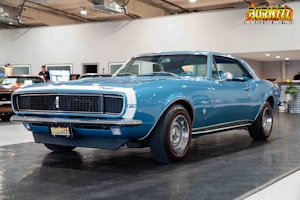Media | Articles
Look inside a $300,000 Formula 1 Transmission
The goal of Formula 1 is to push the limits of motorsport through innovation and development of new technologies. That means the parts and pieces that comprise an F1 car are often somewhat similar to the parts of your road-going car, except not very similar at all. Yes, an F1 car has a sequential manual transmission, but it looks nothing like the manual transmission in any of my cars and I bet nothing like in any of yours, either.
Views inside the parts of an F1 car are relatively rare, since there is the whole competition thing that keeps teams tight-lipped about any and every part that might give an advantage. This means that we as armchair enthusiasts often get to hear about the cool stuff going on inside F1 cars but rarely get to put our eyes on them. Driver 61 on YouTube gave us a look inside one of the more interesting bits of an F1 car recently though, and it was surprising in how unsurprising it was.
The transmission of any car is designed to multiply the torque of the engine to create usable power. The gears make it possible for the relatively narrow power band of the engine to sustain and accelerate from speeds between 45 mph and 200 mph. That’s a big range. Hence why modern F1 transmissions have eight forward gears that ensure the engine is always at peak power. Those gears are not as interesting as the transmission case, however.

Formula 1 cars are built to be as light as possible, or at least as light as the rulebook allows. This means trimming weight at every opportunity and adding it back to the location of the engineer’s choice in order to make weight. This leads to ideas like how the transmission case is a stressed member of the car’s chassis. The rear suspension is literally bolted to the transmission case. No simple aluminum case would do. Instead, this transmission is constructed with additive manufacturing—3D printing—out of titanium rather than starting with a billet and machining away everything not needed.
The case and the parts inside might be made of exotic materials, but the gearbox itself is a simple sliding-gear transmission that can be found in cars dating back a hundred years. My 1930 Ford Model A coupe has a non-synchronized sliding-gear transmission. Subtle changes to the design have made the F1 transmission shift nearly instantaneously compared to the humble double-clutching needed in my old Ford.
Marketplace
Buy and sell classics with confidence


The shifting is controlled by hydraulics that turn shift drums similar to those found in motorcycle transmissions, which move shift forks to engage select gears. No shift lever to be found, and the shift drums operate in unison to engage and disengage multiple gears, making the shifts lightning fast in a way that cannot be done with a hand-operated shift lever.

Also interesting is something that only gets a casual mention in Driver 61’s video, and that is the use of a bevel gear for the 90-degree power transmission required to get the crankshaft rotation turned to match the rear-wheel direction. Most cars use a ring-and-pinion setup, but that configuration puts considerable forces into the chassis, which makes tuning difficult. Somehow this 3D-printed box is strong enough to act not only as the suspension pickup points, but as a brace to hold the power transfer of the bevel gears.

Parts are getting pretty wild and exotic, at least in the top tiers of racing. The concepts behind how they end up looking the way they do are fairly simple, though. After all, if I could print my own titanium transmission case, you bet I would. Wouldn’t you?
***
Check out the Hagerty Media homepage so you don’t miss a single story, or better yet, bookmark it. To get our best stories delivered right to your inbox, subscribe to our newsletters.

















I remember watching the F1 race at Zandvoort on tv in 1967. Jim Clark blew everybody away in the Lotus 49 for its first win using a Cosworth DFV, and the suspension was bolted to the chassis/ engine. My Dad, brother and I were glued to the tv (a full 20inches of glorious black and white)!
The parts are very cool to look at.
And just like our 1930 Ford Model A with straight cut gears (for 1st and 2nd), I’m sure the transmission is very noisy!
Of course, just as the transmission is a sliding-gear type, so is the engine like a 1930 Model A – four stroke combustion, needing fuel mixed with air, and a spark to keep it going. Same but different…
Same with computers I work with – they’re the same basic function as decades ago, just smaller, faster and use less power. Same but different…
Maybe, maybe, we’ll get some of those 3D printers for DIY types that affordably print titanium parts, hopefully sooner rather than later.
What about the Scarabs with Woolworth’s Lance Reventlow at the wheel. Didn’t they have a secret automatic transmission! What became of that innovation?